Can I Be Sedated for a Routine Dental Cleaning if I’m Very Anxious?
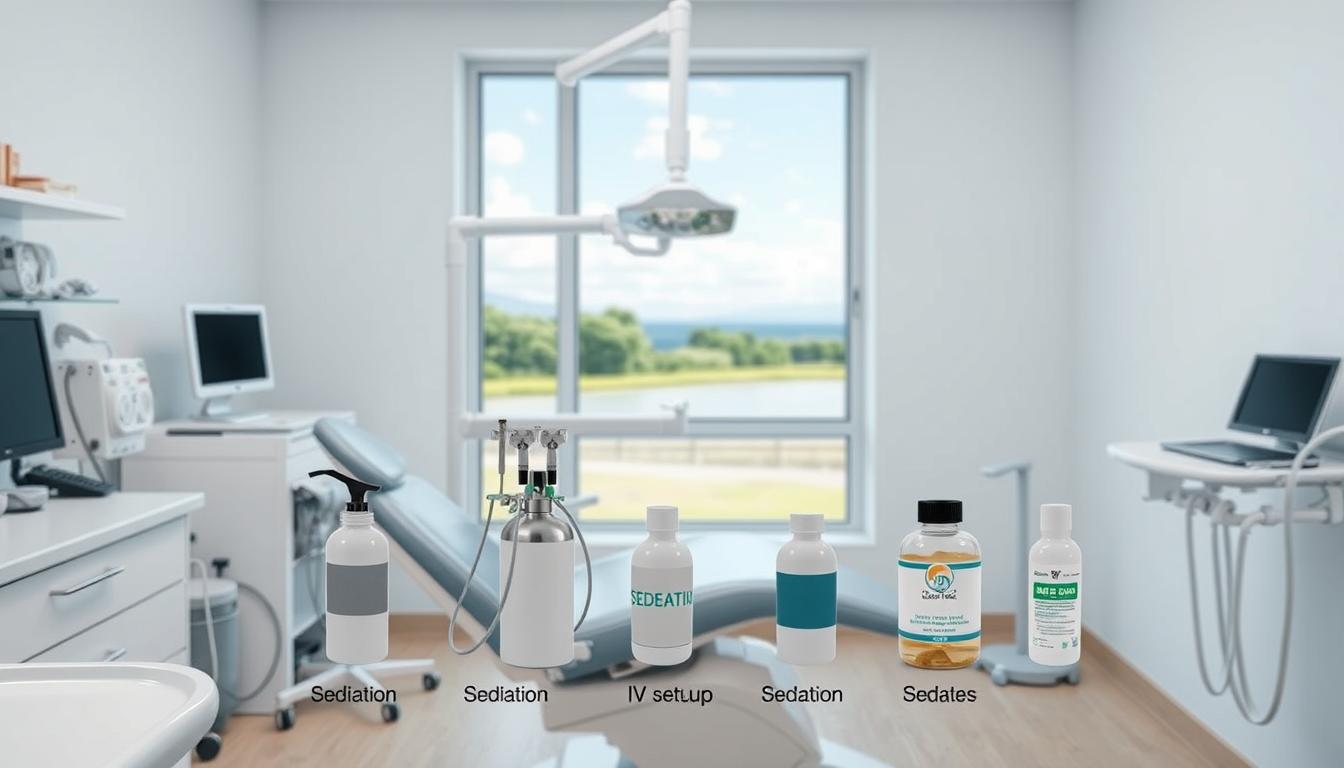
Does the thought of a dental checkup make you nervous? Many people wonder if sedation can help them relax during cleanings. Regular dental visits are key for good oral health, but anxiety can hold people back.
Modern clinics in the U.S. offer sedatives to help you feel calm. This makes even routine cleanings more comfortable.
Can you get sedated for a routine dental cleaning if you’re really anxious? This question has led to new ways to make dental care easier. Dentists now use methods backed by research to help patients relax.
This way, patients can get the care they need without feeling too stressed. We’re here to share the benefits of sedation dentistry. It helps make regular dental visits a breeze.
Key Takeaways
- Early sedation discussions with a qualified dentist boost comfort and confidence.
- Routine cleanings are more manageable when anxiety is addressed through gentle medication.
- Appointments become easier to schedule and maintain with sedation options for dental cleanings.
- Consistent oral health checks prevent bigger problems from developing.
- Using sedation can remove the fear that keeps many from essential dental care.
Understanding Dental Anxiety
This feeling can stop many from getting the care they need. Spotting warning signs and looking into dental anxiety relief can help. It might encourage people to get professional help before problems get worse.
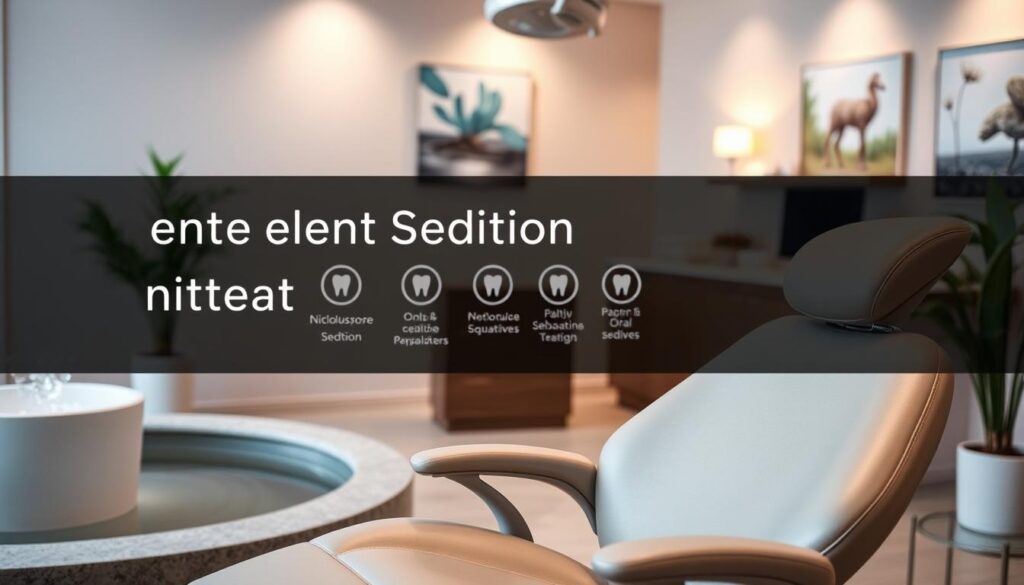
What is Dental Anxiety?
It’s a nervous reaction to dental visits or procedures. People might feel scared or worried about checkups, cleanings, or big treatments. This fear can cause them to cancel appointments, which can harm their teeth and health.
Common Causes of Dental Anxiety
Bad past experiences can make fear last. Finding out what causes the fear can help manage it. Common reasons include:
- Memories of painful or unexpected outcomes
- Fear of needles or injections
- Distress from dental sounds or smells
- Lack of trust in treatment
Symptoms of Dental Anxiety
Some people feel their heart racing and palms getting sweaty. Others might have trouble sleeping before a dental visit. These signs show growing fear and the need for help. Dentists offer dental anxiety relief, like sedation, to make visits easier. Spotting these signs early can help avoid missed appointments and build confidence in dental care.
Types of Sedation Dentistry
Many people feel nervous about going to the dentist. Sedation options for dental cleanings offer personalized solutions. Some want a gentle calm, while others need a deeper relaxation.
These sedation options help those who might avoid dental care because of fear. Each method ensures comfort and safety for the patient.
Nitrous Oxide: The Laughing Gas
This gas makes you feel calm and relaxed. You stay awake but feel less anxious. You can go back to your day right after.
Oral Sedation: Medication Solutions
Oral sedation uses pills to help you relax deeply. You might need someone to drive you home because of the sedation.
IV Sedation: For Deeper Relaxation
IV sedation works fast and can be adjusted as needed. It’s for those who feel very anxious.
| Sedation Method | Application | Benefit | Note |
|---|---|---|---|
| Nitrous Oxide | Inhaled | Quick Recovery | Mild Relaxation |
| Oral Sedation | Medication | Deeper Calm | Escort Needed |
| IV Sedation | Intravenous | Immediate Effect | Closer Monitoring |
Benefits of Sedation for Dental Cleanings
Sedation options can make dental visits less scary for those who fear the treatment chair. It creates a calm space, boosting patient confidence. This method tackles emotional worries and shortens appointment times.

Reducing Anxiety and Fear
Many patients worry about discomfort. Sedation keeps them calm and steady. Deep breathing and gentle words help lower stress.
Those concerned about discomfort during cleanings can find useful info in this helpful blog.
Enhancing Comfort During Procedures
Sedation relaxes the jaw and neck, reducing gag reflex and body movement. People often find the experience easier. This helps keep focus on the cleaning.
Increasing Treatment Efficiency
A calm patient lets the dental team work faster and better. Fewer breaks are needed. This leads to fewer visits and better oral health over time.
Who Can Benefit from Sedation?
People who get really nervous just thinking about dental tools can find big relief with sedation dentistry. It makes them feel calm and relaxed. This helps many patients who need extra help during their dental visits.
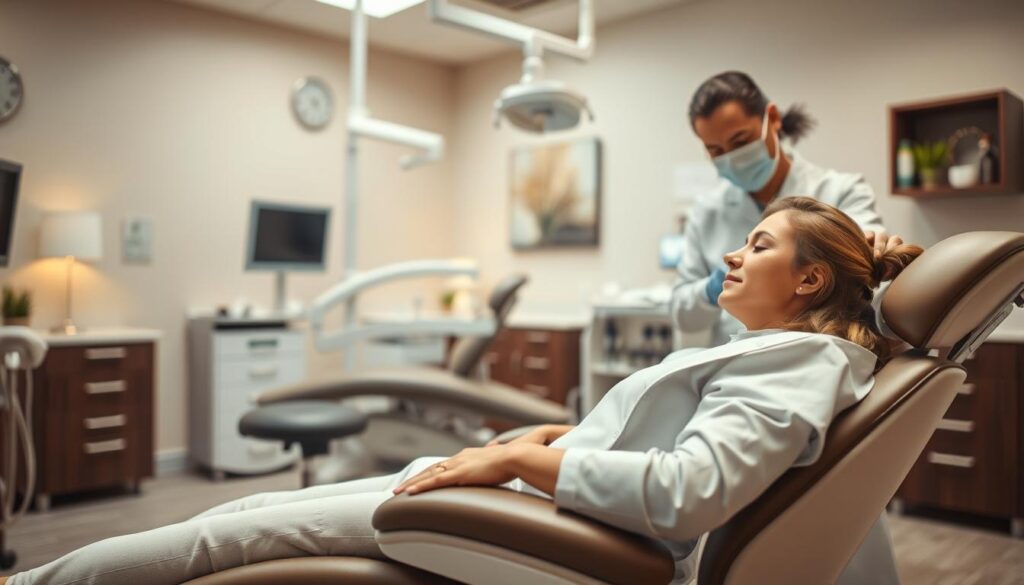
Patients with Severe Anxiety
Some people get so nervous that even simple dental visits are hard. Special sedatives help calm them down. This way, they can get the care they need without feeling too stressed.
Individuals with Previous Dental Trauma
Those who had bad or scary dental experiences often don’t want to go back. Sedation helps them face their fears. It turns scary memories into something they can handle, helping them trust dental care again.
Those with Special Needs
People with special health needs might find regular dental visits tough. Sedation helps address their physical or mental challenges in a calm place. This thoughtful approach makes sure they get the care they need, improving their dental health.
The Process of Sedation Dentistry
Many people use sedation dentistry because of past dental fears. It makes dental visits more comfortable and relaxing.
Initial Consultation and Assessment
A dentist first reviews your medical history. They find the right sedation level for you. This includes checking for allergies and health issues.
What to Expect During Sedation
You’ll get medication to relax. You might feel sleepy but can talk. This makes dental work less stressful.
Post-Procedure Recovery
Have someone drive you home if you’re sedated a lot. You might feel a bit fuzzy for a while. Resting helps you heal better. Sedation dentistry is a good choice for those who want a calm dental visit.
Safety Considerations for Sedation
Sedation makes patients feel calm and relaxed. It helps create a pleasant dental visit. But safety is always the first concern. It’s important to choose sedation options carefully, considering each person’s health.
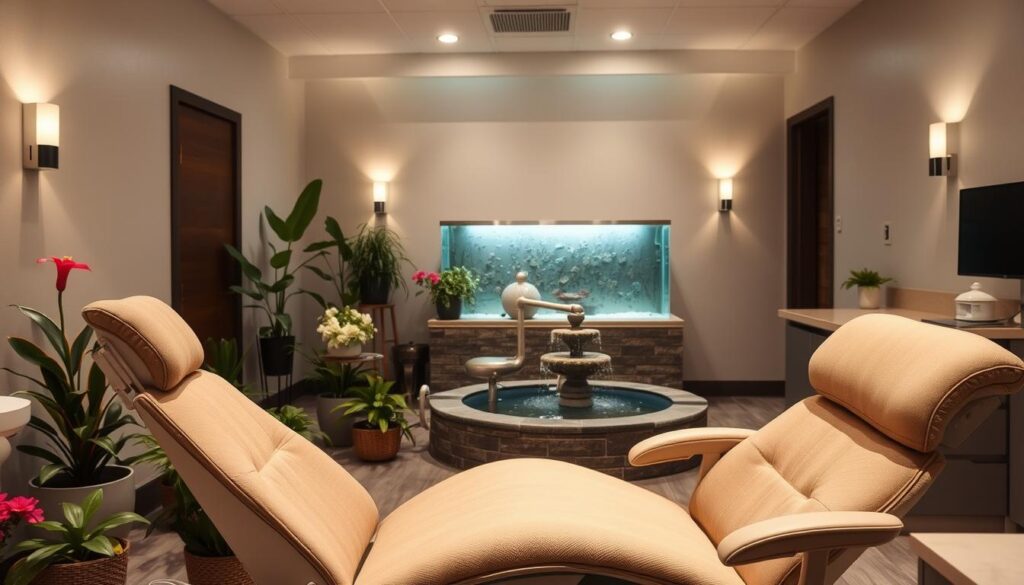
Monitoring During Dental Procedures
Experts closely watch patients’ vital signs. They check pulse, blood pressure, and oxygen levels. This careful monitoring helps catch any issues early, ensuring the patient’s safety.
Potential Risks and Side Effects
Some people might feel a bit drowsy or have unexpected reactions. But, with the right dose, serious problems are rare. It’s key to tell the dentist about any health issues or allergies and follow their advice on medications.
- Minor drowsiness or grogginess
- Rare allergic reactions to sedatives
- Lingering fatigue after procedures
Importance of Choosing a Qualified Dentist
Finding a dentist skilled in sedation is essential. Look for one who is licensed, keeps up with education, and has experience. Before your visit, research different dentists to find the right one for you. For more on dental care, check out this resource. Trusting your dentist is the first step to a comfortable visit.
| Common Monitoring Tool | Purpose |
|---|---|
| Pulse Oximeter | Tracks oxygen saturation |
| Blood Pressure Cuff | Measures blood pressure at regular intervals |
| ECG Machine | Observes heart rate and rhythm |
Preparing for Your Sedation Appointment
Patients want a smooth experience and focus on planning. It’s good to talk about medical history and current meds with a dentist. This helps avoid surprises. Many look for ways to relax before the appointment.
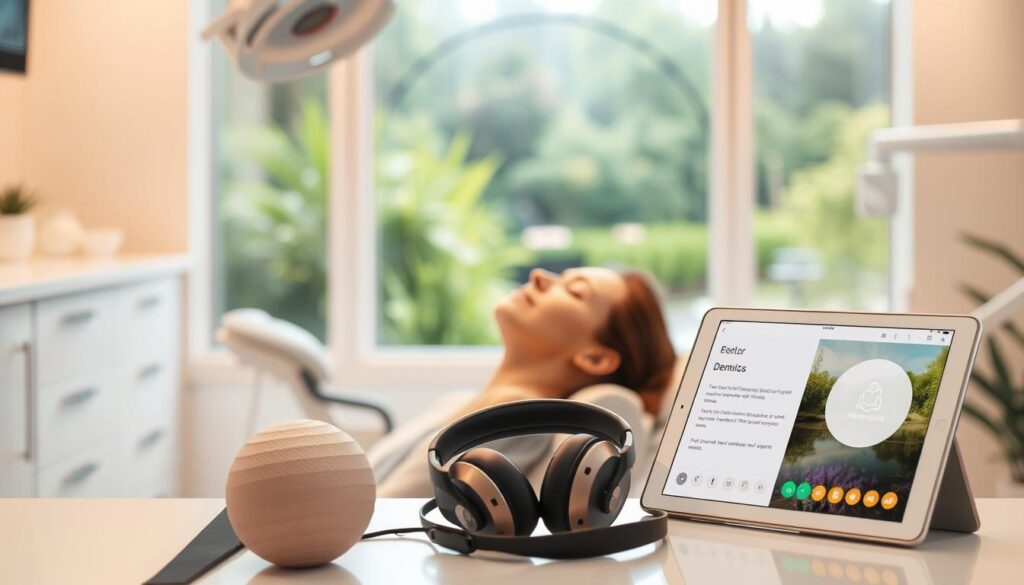
Consultation Checklist
Some ask if they should list their meds or health issues. Yes, these steps are key:
- Share any allergies or current treatments
- Confirm the right sedation approach with your dentist
- Plan questions about comfort and post-sedation care
Dietary Restrictions Before Sedation
Some sedation needs fasting to work well. Doctors might say to have an empty stomach. The American Dental Association can help with how long to fast.
Arranging Transportation Post-Procedure
Patients often need a ride home after sedation. Having someone to drive you is safe and helps you relax. Good planning is key to a calm dental visit.
| Preparation Step | Key Benefit |
|---|---|
| Consult with Dentist | Ensures tailored sedation plan |
| Observe Fasting Rules | Reduces sedation-related risks |
| Arrange a Ride Home | Promotes safe recovery |
Cost of Sedation Dentistry
Many people choose sedation for dental visits to feel less stressed and more comfortable. The cost can change based on what’s needed. Talking to the dental team helps understand the fees for each method and how long the visit will be.
Factors That Influence Cost
Several things affect the final price, including:
- Type and depth of sedation
- Medication dosage
- Treatment complexity
Prices might change if the visit is longer or needs more watching.
Insurance Coverage for Sedation
Some plans cover sedation for dental visits under specific rules. If you meet these rules, you might get part or all of the cost back. It’s smart to check with your insurance to know the details.
Payment Plans and Financing Options
Payment plans help make dental care more affordable. Many dental offices work with financing companies for easy payments. Talking about your budget can lead to solutions that make you feel better.
Alternatives to Sedation Dentistry
Some people wonder, “Can I be sedated for a routine dental cleaning if I’m very anxious?” There are many sedation options for dental cleanings. But, some patients might prefer not to use medication. Anxiety can lessen when people try gentle strategies to stay calm and focused.
These methods can make dental care better and help patients communicate better with their dental team.
Relaxation Techniques
Deep, controlled breathing can help before and during the cleaning. Some use guided visualization to imagine peaceful scenes. Simple muscle relaxation exercises can also help relax tense areas.
Distraction Methods
Audiobooks or podcasts can distract the mind. Soothing music can also help by masking clinical sounds. Virtual reality headsets offer a tech-friendly way to escape.
Communication with Your Dentist
Talking openly about your worries can change your dental visit. Dentists can adjust the environment to make you feel more comfortable. They might change the lighting, use certain tools, or give more breaks.
Sharing what you prefer helps find a way that works just for you. This can replace anxiety with confidence.
Personal Stories and Testimonials
Many people have overcome deep fears with sedation dentistry. They found hope in real-life stories. These stories show that there are reliable ways to manage dental anxiety.
Experiences from Sedated Patients
A Mayo Clinic patient had a moment of calm during a cleaning. This calm led to better care and less pain.
“I never expected sedation to make me feel so calm,” noted a University of Washington patient.
How Sedation Changed Their Dental Care
Restless nights before appointments turned into peaceful sleep. What was once scary became routine. This change made dental visits much easier.
Encouraging Others to Seek Help
Success stories motivate others to explore dental anxiety relief. Once fear is replaced with trust in sedation, progress seems possible.
| Sedation Type | Benefit | Ideal For |
|---|---|---|
| Nitrous Oxide | Mild relaxation | Frequent mild anxiety |
| Oral Sedation | Reduced tension | Moderate apprehension |
| IV Sedation | Deep calm | Severe anxiety |
Sedation Dentistry Myths
Many people worry about sedation for dental visits. They might think it’s too risky. But, knowing the truth can help them feel better and make good choices.
Debunking Common Misconceptions
Some think sedation makes you completely out. But, it usually makes you relaxed but awake. Others believe it’s only for big surgeries. But, it’s also used for simpler dental work.
Understanding Real Risks vs. Perceived Risks
Real risks include the right dose and a dentist’s watchful eye. Dentists follow strict rules to keep patients safe. But, old stories can make people think sedation is riskier than it is.
The Truth About Sedation Effects
Some fear they’ll feel drowsy for a long time. But, mild sedation goes away quickly. With careful watching, side effects are rare. It’s a great way to feel calm during dental visits.
| Common Myths | Facts |
|---|---|
| You always lose consciousness | Light or moderate sedation keeps patients alert |
| Sedation is too risky for simple visits | Professionals tailor safe methods for a range of treatments |
Finding a Sedation Dentist
Many people look for sedation dentistry to ease their anxiety. It’s important to find a dentist who is both skilled and caring. Look for someone with the right training, who follows safe sedation practices, and has positive feedback from patients.
Researching Qualified Professionals
Start by checking state licensing boards and the American Dental Association. Their lists show dentists who have completed the necessary training. Also, look at reviews to see what others say about the dentist’s care.
Questions to Ask During Consultation
- What sedation levels do you provide?
- How do you handle monitoring and safety?
- Are there any limitations based on my medical history?
Verifying Credentials and Experience
Dentists with sedation certificates often have success stories and patient feedback. This information shows their skill in handling sedation for anxiety. Working with a seasoned professional can make you feel more at ease.
Legal and Ethical Considerations
Dentists have a big responsibility to keep patients safe during dental cleanings. They follow rules from groups like the American Dental Association. Being open and honest with patients is key to building trust.
Staying up-to-date with local laws and education is important. This helps dentists use the best sedation methods. It makes sure patients are comfortable and that dentists act ethically.
Informed Consent in Sedation Dentistry
Getting consent is more than just a signature. It lets patients ask questions and share worries about sedation. Dentists explain the sedative, what to expect, and possible side effects. This helps patients feel more at ease during dental cleanings.
Ethical Practices for Sedation Administration
Good ethics put patients first. Dentists check medical histories, watch vital signs, and follow strict rules. This makes patients feel secure and respected in their choices.
The Future of Sedation Dentistry
New ways in medication and watching over patients are changing dental care. New formulas with less side effects are helping those who are very stressed. Sedation dentistry is leading these changes, making visits easier and less scary.
Advancements in Sedation Techniques
Scientists are looking into ways to make patients more comfortable with less medicine. They’re working on better ways to give medicine and improving IV sedation for each person. These steps aim to make the process safer and just as effective.
Trends in Patient Comfort
More focus is on making patients relaxed and calm. Some dentists use things like sensory therapy or guided breathing to help. This makes patients feel more at ease and helps them come back more often.
The Role of Technology in Reducing Anxiety
Headsets with virtual reality take patients to peaceful places during their visit. Wireless monitors keep an eye on heart rate and oxygen levels without getting in the way. These tech advancements help clinics make care better and feel safer for everyone.
Conclusion: Taking the First Step Towards Comfort
Many people who are nervous at the dentist put off important dental care. Sedation can change this, making each visit less stressful. It helps those who are very scared and want a better way to stay healthy.
Encouragement for Anxious Patients
It’s normal to feel nervous in the dentist’s chair. Techniques like deep breathing or guided imagery can help with mild anxiety. But for deeper fears, sedation is a stronger choice.
Sedation works well with other relaxation methods for dental visits. It helps patients feel more at ease. This way, they can regain confidence in their dental care and improve their overall health.
Final Thoughts on Sedation Options
There are many ways to relax during dental visits, like nitrous oxide and IV sedation. Each method aims to reduce stress and ensure a good outcome. It’s wise to talk about your medical history, comfort levels, and costs with a skilled dentist before choosing.
How to Schedule Your Consultation
Talking to a trusted dentist is a big step towards feeling more at ease. Dentists who focus on sedation can answer your questions and create a plan just for you. A consultation is a chance to learn how sedation can help you keep up with dental care and enjoy a healthier life.


